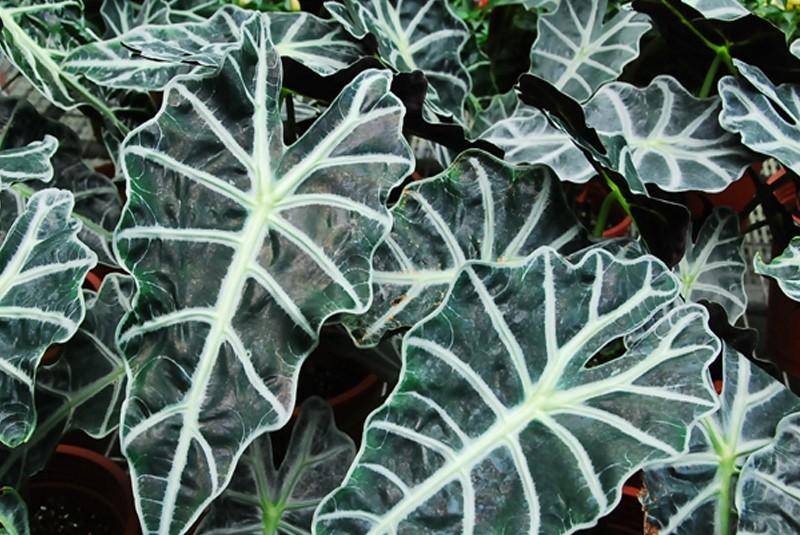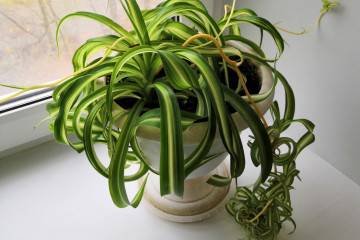Alocasia flower - home care
Content:
Alocasia is a flower, the species diversity of which is striking in the difference in length, leaf shape, size, and color. The plant is very popular for home growing. It is classified as decorative deciduous and is valued primarily for the beauty of large bright leaves. Alocasia will fit well into any interior, it is also suitable for growing in conservatories.
What does alocasia look like?
Alocasia is a herbaceous representative of the Aroid family. It is an evergreen tropical flower. It occurs naturally in the moist warm forests of Ceylon, Indonesia and Malaysia. In natural conditions, when nothing interferes with the grass, and it feels comfortable, its height can reach 4 m. Domestic species are more compact, some of them grow only up to 40 cm up, but there are also those that grow up to 2 m in height. ... The width of the sheets also depends on the type - from 30 cm to 1 m.
The growth rate of home alocasia is small, about 5 new leaves appear per year, each new one larger than the previous one. For their size, they are called "elephant ears". Sometimes in spring, alocasia blooms. Like most members of the Aroid family, the inflorescence is an ear emerging from a large perianth.
Common varieties
All types of alocasia are divided in height into large (more than 1 m) and compact (less than 1 m). The main plant varieties are described below.
Alocasia large-rhizome is a very tall and large-leaved species. Even at home, it can grow up to 5 m, while its diameter will be about 2.5 m. It will definitely require a lot of space. This variety has many hybrid varieties adapted for indoor and garden conditions. Leaves are light green monochrome, long (up to 120 cm), wide (up to half a meter) with finely toothed edges, located almost vertically.
Alokazia Black Velvet is a variety well suited for indoor cultivation. The stem is low (10 cm), the maximum length of a rounded or oval leaf is 35 cm, width is 25 cm, height is up to half a meter. The color of the decorative leaves is unusual: their lower part is painted green, and the upper part is dark green, almost black, it is velvety with a metallic sheen and bright white veins. Flowers are collected in a pink ear up to 10 cm.
Alokazia Kalidora is a hybrid variety, reaching 2 m in height, with long (up to 1 m) and wide (up to 70 cm) leaf plates. The color is light green. The cultivar will require slightly more space to grow than other domestic varieties.
Alokazia amazon is a hybrid decorative-deciduous variety, the leaves grow on petioles of pink-green with dark strokes of color. The petioles are about 50 cm long, the leaves are very showy, thyroid-shaped with a Y-shaped cut. They are dark green with bright white streaks and wavy edges.
Alocasia Sander is a tall species. Its height is up to 2 m, the length of the thyroid elongated dark green leaves with a glossy tint is about 40 cm, the width is up to 15-20 cm. The leaves are outlined with a white border along the edge, the veins are also highlighted in white.
Large-root alokazia (thick-stemmed, Indian, Arma) is practically unpopular in Russia. Its height is up to 2 m at home, in nature - up to 5 m. Leaves are long-petiolized, large, up to 1 m, light green.
The variety Dragon (the second name is Dragon skin) is popular and textured. Its leaves are heart-shaped, pointed towards the end, of a very unusual color, reminiscent of dragon skin. The leaf plate is light green in color with a pronounced metallic sheen. The flower is less than 1 m in height, the leaves drooping due to their weight, which the cuttings cannot hold.
Bambino is a hybrid variety of alocasia, very compact, only 40-60 cm high. Leaves are dark green narrow with white veins.
Alokazia Polly is a decorative leafy hybrid loved by flower growers. Its height is slightly more than half a meter. The stem is shortened, the leaves grow directly from the root rosette, their length is about 50 cm, width is 20 cm. The dark green glossy color with bright white veins and jagged edges looks impressive. Home care for Polly's alocasia is not very difficult, for which she attracted lovers of indoor plants.
There are many other popular varieties of alocasia: Lauterbachiana (Lauterbach, Lotherbachiana), Corazon, Sarian, Kukulata, Kupreya, Macroriza. Thanks to such a variety, everyone can choose a flower to their liking and the most suitable for the interior and size of the room.
Features of home care
To grow alocasia flower, home care must be regular, continuous. Then the plant will respond with rapid growth and reveal itself in all its glory.
Temperature
Temperature is an important part of caring for this hot tropics. In summer, the permissible range is 20-27 ° C. If it is a little hotter, this will be transferred by the flower normally, but constant spraying will be needed, low temperatures, on the contrary, are unbearable. The plant will stop growing and developing. In winter, the minimum permissible value is 15 ° C, but it is better if it does not reach it.
Lighting
Lighting should be bright, but diffuse. Direct sunlight can cause burns. With insufficient light, flower growth slows down, and the leaves become smaller. Optimal placement - western or eastern window sills, in the south you will need shading in the summer months, on the north side - additional lighting in winter.
Watering
Watering must be approached very carefully. Excess moisture is as dangerous as lack of moisture. The frequency of the procedure directly depends on the temperature. For example, in winter, with insufficient light and low temperatures, it is required to water the flower only once a week. In summer it is necessary to water 3 times more often. The water should not be cold, soft, well-separated.
Spraying
This procedure is necessary for the plant because of the rainforest where it comes from. With its help, the flower develops and grows more actively, and its immunity is also strengthened. It is preferable to spray the underside of the leaf plate, daily in summer, less often in winter, depending on lighting and temperature. It is sometimes helpful to have a warm, refreshing shower. The main thing is to do it carefully, trying not to damage the delicate leaves.
Humidity
Alocasia loves high humidity, so it needs regular spraying. Also, there should always be a bowl with wet expanded clay or water nearby. The best option is a humidifier.
Priming
The most important rule when choosing a substrate is looseness, breathability, lightness. The simplest solution would be to purchase ready-made soil for aroids. You will need to add crushed charcoal and earth from a coniferous forest to it. For self-preparation of the substrate you will need:
- soil for orchids (4 parts);
- garden soil (3 parts);
- peat (2 parts);
- perlite (1 part);
- sphagnum (1 part).
Top dressing
Fertilization is required from the end of March to the end of September, 2 times a month. After watering, the soil is fertilized with any complex composition for decorative deciduous plants, diluted in half. Feeding with bird droppings is also possible, but it is too concentrated, so it must be diluted with water in a ratio of 1:30.
Features of winter care during the rest period
From late September to early March, alocasia enters a dormant period associated with a decrease in daylight hours and a decrease in temperature. Therefore, it is required to completely stop feeding, make watering and spraying more rare.
When and how it blooms
It is very difficult to achieve flowering of a plant in a house or apartment. And this is required only if it is essential for the owner that his alocasia is exceptional and still flourish.
The cob inflorescence consists of small pinkish flowers, covered with a white or green veil. So many representatives of aroids bloom, similarly, and an ear of zamiokulkas looks even more attractive. Only an adult plant blooms, reaching an age of at least 4 years.
Pruning
Flower pruning consists in removing leaves that turn yellow and dry in time. They are cut off with a sharp disinfected knife and the slices are sprinkled with crushed activated carbon or sprayed with disinfectants.
How alocasia multiplies
There are 4 ways to reproduce alocasia:
- root nodules - the most popular and effective method. The tubers are disinfected in a root growth stimulator, after which they are planted in a mixture of perlite and sphagnum, covered with a foil with holes and kept at a temperature of 25 ° C. As soon as the roots appear, you can dive future plants in different pots;
- dividing the rhizome. A part is separated from the mother rhizome, disinfected, planted in a mixture of peat and sand. Shade for a couple of days, then just watered and sprayed;
- cuttings. A shoot with 1-2 buds is separated, it is kept for a day in a root growth accelerator, planted in peat mixed with sand, covered with polyethylene, in which holes are made for ventilation, the soil is watered, the cutting itself is ventilated and carefully sprayed. After rooting (after 3-4 weeks), it can be transplanted to a permanent place;
- growing from seed is a very long process and is only suitable for non-hybrid varieties. It is carried out similarly to the previous ones, only first you need to germinate seeds in a sand-peat mixture.
Transfer
To transplant alocasia, you need to get the flower out of the pot, shake it off the ground as much as possible, gently rinse the roots with warm water and examine them. If nodules appear on them, new plants can be grown. The mother bush needs to be planted in a new pot, tall and not too wide. Plastic flowerpots work best.There should be a good drainage layer at the bottom of the pot, with a layer of soil on top. The bush is carefully placed on the ground and all voids are filled with a ready-made substrate.
Pests and diseases
If all conditions are created for the plant, then its immunity is high enough, and pests and diseases do not threaten it, which means that it will not have to be treated. The most common parasitic insects are:
- aphid;
- shield;
- spider mite;
- mealybug.
Signs that a home alocasia plant needs treatment are:
- the appearance of spots on the leaves (yellow, brown, bicolor). Spots are an indicator that the plant is feeling bad;
- yellowing, dropping, wilting, crushing of leaves;
- complete loss of leaves;
- rot on any part of the flower.
Insecticides will help against insects, and fungicides will help against diseases.
These are all signs of various illnesses caused by improper care. To avoid this, you need to follow all the rules, then you will not have to treat the flower. Well-groomed alocasia is not susceptible to disease.
Alocasia is a very beautiful, original, exotic plant that loves space and proper care. If you provide her with everything that the plant needs, she will give the owner an excellent appearance, will delight her with large bright, wide leaves. Taking care of her is not always easy, but the result is worth it.






















